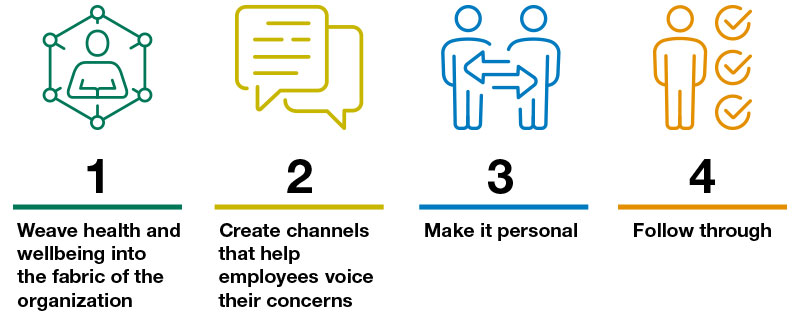Employee mental health and wellbeing are core foundations of business success. Essential for individuals to lead happy, fulfilling lives, they are also critically important from an economic perspective. The lost productivity resulting from trauma, depression and anxiety costs the global economy an estimated $1 trillion USD each year. And for businesses, poor mental health can lead to lower employee engagement and productivity.
In the face of a changing climate, the link between health and wellbeing and the environment is becoming ever clearer. So much so that the 2022 World Health Day, led by the World Health Organization, highlighted the climate crisis as a health crisis. And the latest research from the IPCC (Intergovernmental Panel on Climate Change) supports this – as the climate continues to warm, billions of people will experience worsening physical and mental health.
The impacts of the climate on mental health
Any climate change impact that brings physical ill health also has consequences for mental health. Natural disasters are known to increase the number of people who are more susceptible to mental health conditions such as post-traumatic stress disorder (PTSD), depression and addiction. As extreme weather events – such as the recent floods in Pakistan or Hurricane Ian in Central and North America – become more frequent, more intense and of a higher magnitude, more people will be exposed to increased risks of climate-related illnesses, injuries, mortality, and mental health impacts
But there are also consequences for those observing the impacts of climate change on others and anticipating the impacts it may have on oneself. Climate anxiety, or ‘eco-anxiety,’ is fear, worry or tension rooted in the uncertainty of the future posed by a changing climate, even in the absence of direct impact. This is often accompanied by feelings of grief, anger, guilt, and shame, which in turn can lead to changes in mood, behavior, and thinking.
‘Solastalgia,’ a term coined by Glenn Albrecht in 2007, describes the emotional distress that people feel when environmental change impacts their environment. This is often exacerbated by a sense of powerlessness and lack of control is further compounded by the increased flow of information about extreme events across the globe, which have become a regular fixture of our news cycles and social media feeds.

From environmental racism to burnout - all are not impacted equally
Businesses must understand that some of their workers have already been experiencing long term economic and social impacts of climate change, heightening the impact on their mental health and wellbeing. Loss of land and livelihoods due to climate change is likely to substantially increase conflict, displacement and forced migration, leading to an increasing number of ‘climate refugees'. These consequences have already and will continue to disproportionately affect already marginalized communities, including Black, Indigenous and People of Color (BIPOC). Termed ‘environmental racism,’ one example of its intersection with climate risk is shown through recent developments in inundation modelling that found Black neighborhoods in the United States to be disproportionately at risk as climate change accelerates flooding.
Environmental justice, a movement in response to environmental racism, seeks to create a community where both cultural and biological diversity are respected. Engaging with climate activism to promote environmental justice can have positive impacts for mental health related to climate anxiety, but it can also result in activism burnout, or even heightened levels of anxiety, frustration, and cynicism when the extent of the climate crisis is further realized and witnessing a lack of action by governments.
National surveys in the United States, Europe and Australia show that people express elevated levels of concern and perceived harm associated with climate change, and according to a survey by the American Psychological Association, more than two-thirds of Americans experience some climate anxiety. But it is young people who are at higher risk. A study published by The Lancet asked 10,000 young people aged 16 to 25 in 10 countries how they felt about climate change and government responses to it. The results found that most respondents were concerned about climate change, with nearly 60% saying they felt ‘very worried’ or ‘extremely worried’, and 45% of participants saying their feelings about climate change impacted their daily lives.
As an extension of this, professionals working in certain fields, geographies or with particularly vulnerable communities who are more exposed to climate change impacts can also be at risk of anxiety and feeling unable to provide ample help and support to mitigate these impacts because of the conditions they are working in. It is important for business to understand therefore, that these cohorts, especially graduates and early career professionals, are more likely to be affected by climate anxiety, and so work to address these concerns in these communities and through their graduate programs.
Practical actions to address climate anxiety in the workplace
With more employees entering the workforce who are more likely to experience mental health challenges, businesses must advocate for holistic health and wellbeing programs to future proof their business strategies. We have identified four key steps companies should consider:

- Weave health and wellbeing into the fabric of the organization
Similar to steps taken to embed an effective safety culture, this involves assessing the maturity of the current health and wellbeing efforts in place and planning for how this will evolve into the future; integrating and implementing the right health and wellbeing actions to drive change; and collaborating and communicating with employees to drive internal efforts related to health and wellbeing priorities.
This also requires a commitment from leaders themselves to understand how they play a significant role in creating the necessary conditions for optimal wellbeing across teams and across functions. It is clear from the findings of ERM’s 2020 global safety survey that employee mental health poses a significant concern for many organizations, heightened further by the global pandemic. Working with leadership in several organizations has led to the development of our ‘human centered’ leadership program. This helps senior leaders build core wellbeing concepts into day-to-day work, moving organizational focus from short term interventions to more sustainable interventions that address overall worker wellbeing throughout the organization. - Create channels that help employees voice their concerns
Creating forums and opportunities to encourage open conversations can help employees feel empowered to share their personal experiences, especially around events and situations that can escalate climate anxiety. Engagement surveys that include specific questions about the climate change and environmental impacts that employees are facing is another useful channel. They can also be used to check if you are effectively communicating what your company is doing to mitigate climate change, in terms of both commitments and progress made. Examining data from exit surveys could also indicate any disconnect from sustainability strategies.
Taking basic steps such as introducing the language around climate anxiety can help employees cultivate awareness to better understand what they are feeling. However, it is key that the environment created fosters psychological safety for employees to communicate candidly and truthfully. If they sense their anxieties around climate change are not taken seriously, any feedback gathered may not be meaningful. - Make it personal
Creating channels is a crucial step, but it is critical to take the conversation to the employees. We have partnered with several clients to create Wellbeing Mentor programs, colleagues who serve as a connection point to help employees feel comfortable sharing their concerns and even navigating to their next step for assistance. The intention was not to equip the organization with a team of professional psychologists, but rather to provide the employees with a touch point of care and concern and advocating for their wellbeing, whether that was work stress, climate stress or concerns about their ability to perform and meet expectations. One indication of the effectiveness of the program was in the resulting reduction of individuals requiring "stress leave". - Follow through
Investing in resources, such as mental health champions, access to Employee Assistance Programs, and mental health apps can support a culture where employees feel able to take positive action towards any mental health challenges they are facing. Building resilience is one of the key antidotes to poor mental health and one of the methods ERM has incorporated into our own programs by running a series of resilience building trainings, supporting employees dealing with climate anxiety.
Harnessing the power of community within the organization
Businesses have a significant opportunity and responsibility to promote health and wellbeing by recognizing the power of community. Just as Albrecht formed the concept of solastalgia, he also coined the term ‘soliphilia’, which he defined as the “political affiliation or solidarity needed between us all to be responsible for a place, bioregion, planet and the unity of interrelated interests within it”.

While every organization’s journey will be different, embedding employee health and wellbeing within business strategy should be consistent and comprehensive - a culture of wellbeing, supported by leadership commitment, customized and impactful programs, and a sustainable future-oriented approach. By creating a workplace where mental health and wellbeing are prioritized, companies can better manage risks, address stakeholder expectations, reap a host of operational benefits and contribute to building happier, healthier, and more prosperous societies.

